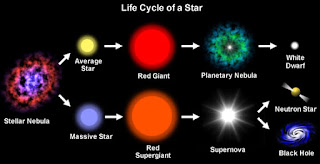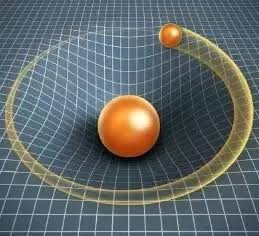LIFE CYCLE OF A STAR!
Outlined below are the many steps involved in a stars evolution, from its formation in nebula, to its death as a white dwarf or neutron star.
NEBULA
A Nebula is a cloud of gas(hydrogen) and dust in space. Nebulae are the birth places of stars. There are different types of nebula. An emission nebula e.g. such as Orion nebula, glows brightly because the gas in it is energized by the stars that have already formed within it. In a Reflection Nebula, starlight reflects on the grains of dust in a nebula. The nebula surrounding the Pleiades Cluster is typical of a reflection nebula. Dark Nebula also exist. These are dense clouds of molecular hydrogen which partially or completely absorb the light from the stars behind them e.g. the Horsehead nebula in Orion.
Planetary Nebula are the outer layers of a star that are lost when the star changes from a red giant to a white dwarf.
Shop now at Amazon Pantry at best deals
STAR
A star is a luminous globe of gas producing its own heat and light by nuclear reactions (nuclear fusion). They are born from Nebula and consists mostly of hydrogen and helium gas. Surface temperature range from 2000°C to above 30,000°C, and the corresponding colours from red to blue-white. The brightest stars have masses 100 times that of the Sun and emit as much light as millions of Suns. Delhi for less than a million years before exploding a supernovae. The faintest stars are the red dwarfs, less than 1000th the brightness of the Sun.
The smallest mass possible for a star is about 8% that of the Sun (80 times the mass of the planet Jupiter), otherwise nuclear reactions do not take place. Objects with less than critical Mass shine only dimly and are termed brown dwarfs or a large planet. Towards the end of its life a star like the sun swells up into a red giant, before losing its outer layers as a planetary Nebula and finally shrinking to become a white dwarf.
RED GIANT
This is a large bright star with a cool surface. It is formed during the later stages of the evolution of a star like the Sun, as it runs out of hydrogen fuel at its centre. Red giants have a diameters between 10 and hundred times that of the Sun. They are very bright because they are so large, although their surface temperature is lower than that of the Sun, about 2000-3000°C. Very large stars are often called Super Giants. These stars have diameters up to 1000 times that of the Sun and have luminosities often 1,000,000 times greater than the Sun.
RED DWARF
These are very cool, faint and small stars, approximately one-tenth the mass and diameter of the Sun. They burn very slowly and have estimated lifetimes of 100 billion years. Proxima Centauri and Barnard's Star are red dwarfs.
WHITE DWARF
This is a very small, hot star, the last stage in the life cycle of a star like the sun. White dwarfs have a mass similar to that of the Sun, but only 1% of the Sun's diameter; approximately the diameter of the Earth. The surface temperature of a white dwarf is 8000°C or more, but being smaller than the Sun their overall luminosity is 1% of the Sun or less.
White dwarfs are the shrunken remains of normal stars, whose nuclear energy supplies have been used up. White Dwarf consists of degenerate matter with a very high density due to gravitational effects, i.e. one spoonful has a mass of several turns. White Dwarfs cool and fade over several billion years.
SUPERNOVA
This is the explosive death of a star, and often results in the star obtaining the brightness of 1,000,000 million Suns for a short time. There are two general types of supernova:–
1. These occur in binary star systems in which gas from one star falls onto a white dwarf, causing it to explode.
2. This occur in stars 10 times or more as massive as the Sun, which suffer runaway internal nuclear reactions at the end of their lives, leading to an explosion. They leave behind neutron stars and Black Holes. Supernovae are thought to be main source of elements heavier than hydrogen and helium.
NEUTRON STARS
These stars are composed mainly of neutrons and are produced when a supernova explodes, forcing the protons and electrons to combine to produce a neutron star. Neutron stars are very dense. Typical stars having a mass of three times the Sun but a diameter of only 20km(12.428miles). If a mass is any greater, its gravity will be so strong that it will shrink further to became a Black Hole. Pulses are believed to be neutron stars that are spinning very rapidly.
BLACK HOLES
Black Holes are believed to form from message stars at the end of their life times. The gravitational pull in a Black Hole is so great that nothing can escape from it, not even light. The density of matter in a Black Hole cannot be measured. Black Holes distort the space around them, and can often suck neighbouring matter into them including stars.
To learn motor fitness test for youth click here: Fitness Test
Click here for learning about Business Financing: Business Finance
THANK YOU.











V. Gud
ReplyDelete